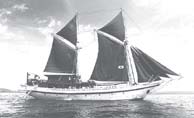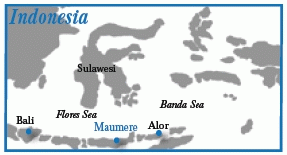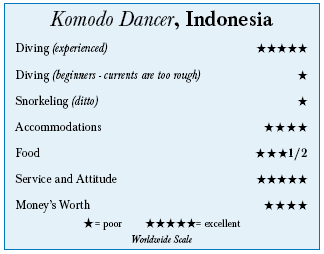Komodo Dancer, Flores Sea, IndonesiaContents of this Issue: Komodo Dancer, Flores Sea, Indonesia Did Gabe Watson Get Away With Murder? Dive Instructor Jailed for Being Alone With Her Boss Divers, You’re Not Using Enough Sunscreen Can Saunas Prevent Decompression Sickness? Go Where No Diver Has Gone Before Where Have Hawaii’s Fish Gone? Passport Tips for Traveling Divers Dive Gear Warranties: Always Honored? Editorial Office: Ben Davison Publisher and Editor Undercurrent 3020 Bridgeway, Suite 102 Sausalito, CA 94965 kaleidoscopic rainbow diving in the Alor Archipelago from the July, 2009 issue of Undercurrent
Dear Fellow Diver: We were moored in Beang Bay, Pantar, after taking two muck dives in front of a tiny village. Because sanitation doesn’t exist in these remote parts, I wondered what other “muck” there might be in the water in addition to the clothing, shoes and a goat burial ground. Black volcanic sand set up the small undersea life for easy spotting. Though the dive sightings were varied and prolific, I was ready for a change of scene -- and got it. Garry Bevans, in charge of Komodo Dancer’s dive operations, and Ralph Buck, the intrepid leader of Rainbow Dive Adventures for gay and lesbian divers, were going to explore a new site on the corner of the island. I tagged along. Of all my 32 dives, I came the closest to losing my reg here in slack-jawed awe - - a sloping reef to a steep wall, fivefoot- high barrel sponges, and coral outcroppings stretching to 15 feet. The floor of the reef was covered with rippling sea anemones and soft corals in rainbow hues. Hiding there were shortfin and pygmy lionfish, clownfish and bright yellow, beautifully tufted flatworms. Cockerel wrasse seemed to claim it as their own spot. Garry postponed overnight steaming elsewhere to dive here the next day. So my second dive had sightings of a dainty, translucent ghost pipefish dancing in the open near a delicate, light pink coral, colorfully beribboned 18-inch clams, spotted devilfish, octopus, various species of nudis, and strap-weed and diamond filefish. Visibility was well over 100 feet. Garry dubbed his find Rainbow Rock n’ Reef, in honor of the dive group on board.
Rainbow Dive
Adventures, a Los
Angeles tour agency for gay and lesbian divers, chartered the
Dancer for 10 days. With straight me along as
the gay ally, eight men and four women dived
the Flores Sea and the Alor Archipelago. The
group lived up to its travel outfitter’s name
-- many colorful personalities ranging in age
from 40 to 70. They included two each of lawyers,
psychologists, engineers and nurses,
with a horse veterinarian, CPA, actor and producer
expanding the mix. After stepping onto
the 98-foot wooden schooner, we all settled on
the deck with the welcome-aboard iced drink,
greatly appreciated in the 95-degree heat and high humidity. There was a lot of daytime steaming to get to dive sites, scattered 200 miles along the archipelago, but the distances seemed short as we passed mountainous islands, several with active volcanoes. I kept waiting for the 600 square meters of sails to unfurl but they never did. Except for Garry, an English expat, the crew of 15 is Indonesian. Sebastian painstakingly took breakfast orders, served meals with a flourish, and was ready with hot chocolate after a night dive. He would give shoulder massages after dives and arrange an hour-long massage with one of the crew for $10. He and divemasters Yan and Gede were the only others who spoke English. First Mate Kasim was substituting for the vacationing captain. Evidently, a year ago, another captain fell overboard and was never found. Whether accident or suicide is a question unanswered by the crew but I gathered he was a controversial character who enjoyed his liquor. Although she was built in 2001, the Dancer, one of Peter Hughes’ fleet, looks much
older and needs TLC. After dives, the sloped, multipurpose forward deck was slick with water, resulting in at least half of the
dozen divers falling. There were some
scraped legs and one more serious accident.
An area covered with an overhead tarp on the main deck includes a long camera counter with air hoses for drying, a huge wooden table seating 16 for meals, benches with basket storage and lines for wetsuits to be hung, mostly in the sun. An indoor salon with quasiefficient air-conditioning had two large tables for computer-laden divers to tinker on. Voltage-charging stations were on deck and in the salon, and digital download and burning facilities were available. The napping divers took over the salon’s two cushioned bench seats while the livelier ones pulled out cold beverages, including beer, from the fridge and dug into fresh fruit and jars of store-bought ginger cookies. The party got livelier when complimentary liquor was set up for cocktails in the late afternoon. We toasted each other from lounge chairs on the partially covered bridge deck, directly in front of the bridge, but it also doubled as a smoking area for crew. My dive buddy and I each got our own room, as the Dancer has seven double cabins. My deluxe queen-bed cabin was spacious with plenty of storage, efficient A/C and a porthole. My large bathroom was tiled with stones (for added ballast, Garry said). Sheets were changed midweek, beds made daily, and robes were provided. Besides the other deluxe cabin, the rest had bunk beds and small bathrooms. The upper deck had two owner’s cabins, one with a double and one with twin beds. Cabins were kept clean but not entirely bug-free. Before the first dive, I had fresh sliced fruit and a croissant, and afterwards came a delicious main breakfast of eggs-of-choice, bacon, hot cereal, pancakes or French toast. Other meals usually had an Indonesian flair. Fish was frequently served, which presented a problem for the two non-fish eaters until the chef provided alternatives, usually chicken. Tasty soups were served before the entrée; the Indonesian chicken soup, soto ayam, was served with sliced cabbage, lemon, chili sauce and white noodles. When the chef omitted the thick white sauces in vegetables and meats, food was excellent, especially the fish satay with sauces. Between afternoon dives, he prepared fried bananas and several chocolate to-die-fors. Service was exemplary, from carefully helping us in and out of tenders to finding misplaced dive gear. Garry was masterful at troubleshooting gear problems so no dives were missed. One diver was a large man whose air disappeared fast. No problem -- a 100-cu-ft steel tank was substituted for the 80-aluminum. On a night dive, one of my integrated weight pouches descended without me. The tender had left after the backroll, but it was a quiet star-lit night with calm seas and no current, so it took less than five minutes to hail them with my dive light. Gede returned the next day, freediving to where he had pinpointed our dive, thanks to GPS. With repetitive diving being the standard, my gas of choice is 32-percent Nitrox but on the second day of diving, the Nitrox generator broke -- a needed part was unavailable. We didn’t have to pay for the six Nitrox dives already taken but still, a bummer. Garry checked currents before each dive but they could change quickly. In the briefings, we were told dives were 60 minutes, but divemasters seemed as enthralled as divers by the sights and thus prolonged dives. Komodo’s web site indicates electronic positioning devices would be issued to divers but they are no longer available. We were required to carry safety sausages, airhorns or whistles, and strobes on every dive. At each briefing, we were reminded to stay with our divemasters and buddies, but this was only reinforced at Wodong Japanese Shipwreck, where kicked-up deep silt narrowed viz to five feet. Even in the muck, our DM spotted a pygmy seahorse, the only one we saw on the trip. Once we set up on deck, we never had to handle gear again until trip’s end. Tanks were filled on deck, then put on one of the two 20-foot fiberglass tenders with twin Yamaha 40hp outboards. But I always check my gear when any crew member sets it up, and once my first stage was put on upside down. Filling and repositioning tanks were labor-intensive for crew, perhaps the reason why dives were limited to four per day. I asked about taking an extra dive but received an emphatic negative. Entries were backroll and when exiting, BCs and weights were removed and handed up before climbing the ladder. The dives were scheduled for 7:30, 10:30, 2:30 and the night dive at 6:30, but varied depending upon the steaming of the boat. Slight surge and one- to two-knot currents were present on half of the dives, particularly in the Alor Archipelago. I was excited about Kal’s Dream, known for its ripping currents and pelagic life. It was near the new moon, the best time to catch this high-current dive in tamer waters. However, with high tide barely covering the sea mounts, currents were dangerously swift and swirling, thus a no-dive. Except for two days of very light chop, seas were calm and visibility was over 150 feet on most dives. Underwater temperatures varied from 73 degrees in Alor, where there were thermoclines, to 85 degrees. I was comfortable in a new 5mm merino-wool lined wetsuit, but my 3mm with vest would have been ample. We steamed overnight to arrive at the active volcano of Batu Tara by dawn to see the lava pouring and belches of smoke accompanied by thunderous rolls. The crew ensconced themselves in a cabin, leery of the destruction a volcano can bring but we divers stood in the open, enthralled and photographing the ash filtering down. Garry decided not to try a dive there, so we steamed three hours to the Ledges of Bacatan at Lembata Island, where at 113 feet, we watched the cruising whitetip and blacktip reef sharks. An eagle ray’s appearance and giant grouper added to our pelagic sightings. Rich and I had great fun differentiating between the common and longspine lionfish by counting pectoral fins and identifying the Indian, spotfin, clearfin, kodipungi, gurnard, zebra and pygmy lionfish. My favorite was the lacy scorpionfish. Other oddshaped fish challenged our ID skills, with frequent spottings of a variety of devilfish and stonefish. Of the waspfish, the cockatoo was most prevalent. It was the norm to see a variety of fish, many schooling, hard and soft coral, anemone, crinoids, and tunicates joining to create a kaleidoscope of colors. Cuttlefish were more difficult to spot, except for an 18-inch pharaoh at the Pomno Kecil wall dive in Maumere Bay. The brilliant blue and yellow ribbon eel appeared on many dives. Among the many species of ghost pipefish I saw were ornate, velvet, and thin, two-inch adults and juveniles. Clown Valley near the island of Pura lived up to its name. The stunning carpet of multi-hued anemone housed only one species of anemonefish, clownfish of all sizes, and hundreds of them. In the crystal-clear water, I could see the thermocline, which dipped to 73 degrees. This was primarily a small-fish dive trip, with few exceptions. During an interval, we saw whales blowing and breaching a half-mile away. We jumped in the tenders but they had disappeared. The most outstanding night dive was at Alor’s Mucky Mosque, named for the mosque in the tiny Muslim village. We started down as the muezzin made the sunset call to prayer. Dive lights easily highlighted critters on the volcanic black sand bottom: leaf fish, 10-inch painted frogfish, a half-inch-long white phase frogfish, three-inch thornback cowfish, ornate ghost pipefish floating in the open, several species of nudibranchs, walking pincushions, zebra crab, shrimpfish, bumblebee shrimp and stately, unfurled sea pens. Dozens of schooling razor fish delighted me with their shape shifting. At trip’s end, I was dreading the Air China Flight from Bali to Los Angeles via Taipei. Cramped seats and dreadful food made the two flights, totaling 18 hours, a nightmare. The 90-minute flight from Maumere to Bali on Merpati Air was a breeze in contrast. To prepare for the ordeal, we stopped at Carla’s, the streetside massage parlor near the Sofitel in Seminyak. It offers an hour for $5 or the “special” of facial, body scrub and massage for $18. Before boarding the flight from hell, we toured the Ubud area, an hour from the airport, staying at the ultra-luxurious Maya Ubud resort, a 25-acre Shangri-la set among rice fields. Was it worth the money? Indeed, as my write-up extols. Under the Flores Sea is another world, seldom dived, alive and pulsing with kaleidoscopic colors, new species awaiting discovery around the next corner. It’s worth missing some Caribbean dive trips to save up and go on just one here. As for the Komodo Dancer, I was impressed with the service, less so with the food, the limit of four dives a day, the failure to have a backup part for the broken Nitrox generator and the deck designed for pratfalls. For Indonesia diving, I would return to the luxury of the well-designed Kararu Voyager. -- C.P.
|

I want to get all the stories! Tell me how I can become an Undercurrent Online Member and get online access to all the articles of Undercurrent as well as thousands of first hand reports on dive operations world-wide
| Home | Online Members Area | My Account |
Login
|
Join
|
| Travel Index |
Dive Resort & Liveaboard Reviews
|
Featured Reports
|
Recent
Issues
|
Back Issues
|
|
Dive Gear
Index
|
Health/Safety Index
|
Environment & Misc.
Index
|
Seasonal Planner
|
Blogs
|
Free Articles
|
Book Picks
|
News
|
|
Special Offers
|
RSS
|
FAQ
|
About Us
|
Contact Us
|
Links
|
3020 Bridgeway, Ste 102, Sausalito, Ca 94965
All rights reserved.


 The best times I spent
above water were during dinnertime when I got to know this great bunch of divers. We
ate alfresco, laughing and joking as the crescent moon mingled with an array of stars,
brighter and bigger without lights to compete or contrails to blur.
The best times I spent
above water were during dinnertime when I got to know this great bunch of divers. We
ate alfresco, laughing and joking as the crescent moon mingled with an array of stars,
brighter and bigger without lights to compete or contrails to blur. One woman was sitting in a chair
on the sloped deck, which slid, tipping
sideways, resulting in a back injury and
reduced diving. In Bali, she went to
the emergency room for x-rays and Divers
Alert Network arranged for her to fly
back in business class.
One woman was sitting in a chair
on the sloped deck, which slid, tipping
sideways, resulting in a back injury and
reduced diving. In Bali, she went to
the emergency room for x-rays and Divers
Alert Network arranged for her to fly
back in business class. Diver’s Compass: Rainbow Dive Adventures’ package, including three
nights in Bali, cost me $5,300 . . . Dancer’s rates for a 10-night
Alor cruise is $2,900 for a twin-bunk stateroom, plus a $90 fuel charge
and $200 for Nitrox; it offers discounts of $150 for seniors 65+, $200
for consecutive charters and 10 percent off for active military and
dive instructors . . . My China Airlines from LAX to Bali was $1,000
and Merpati Airlines from Bali to Flores was $350 . . . Luggage weight
limit for Merpati is 44 pounds (carry-on can reach 11 pounds) and if
it exceeds that by a lot, there’s no guarantee it will arrive at your
destination; I wasn’t charged an overweight fee to Maumere but on the return flight,
it was $1 per kilo over . . . a $25 visa is obtained upon entry at Bali, international
departure tax from Bali was under $15, domestic departure tax Maumere to Bali was about
50 cents . . . Komodo Dancer’s Web site:
Diver’s Compass: Rainbow Dive Adventures’ package, including three
nights in Bali, cost me $5,300 . . . Dancer’s rates for a 10-night
Alor cruise is $2,900 for a twin-bunk stateroom, plus a $90 fuel charge
and $200 for Nitrox; it offers discounts of $150 for seniors 65+, $200
for consecutive charters and 10 percent off for active military and
dive instructors . . . My China Airlines from LAX to Bali was $1,000
and Merpati Airlines from Bali to Flores was $350 . . . Luggage weight
limit for Merpati is 44 pounds (carry-on can reach 11 pounds) and if
it exceeds that by a lot, there’s no guarantee it will arrive at your
destination; I wasn’t charged an overweight fee to Maumere but on the return flight,
it was $1 per kilo over . . . a $25 visa is obtained upon entry at Bali, international
departure tax from Bali was under $15, domestic departure tax Maumere to Bali was about
50 cents . . . Komodo Dancer’s Web site: 